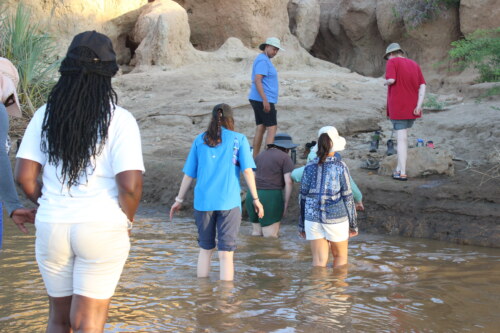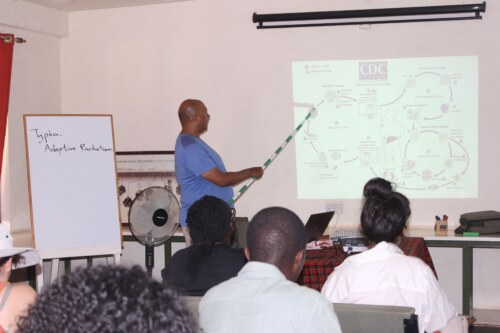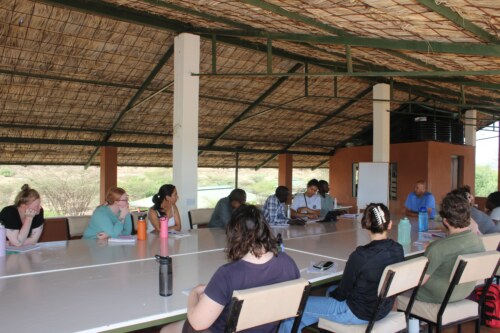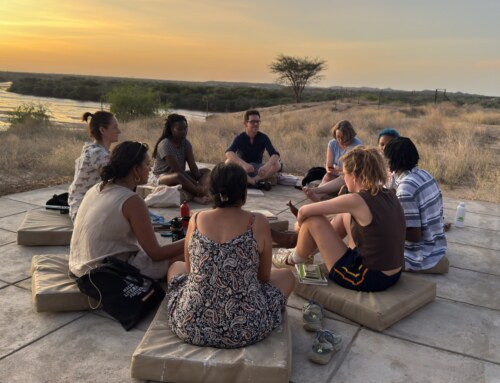Hello all, this entry of the blog comes to you from Edmond and Phoebe, two students at the TBI Origins Field School.
On Monday (the day after we had completed the Great Grevy’s Rally) we all flew in two groupsout to TBI Turkwel, Turkana County. Once at the Mpala airstrip, the tiny Air Turkana plane arrived, and took off over the Rift Valley, heading to the TBI Turkwel facility on the west side of Lake Turkana. From the air, we were able to see the entire landscape, passing over mountains, villages, and plateaus, before watching the rich green vegetation of central Kenya give way to the sandy dry Turkana environment that will be our home for the next several weeks. Once we landed, we were driven to the institute in a large green lorry, and several of us were surprised by the heat and the difference in the landscape between Turkana and Laikipia County.
After reuniting with the students who had left on the earlier flight, we had some time to settle in, and then we walked down to the (currently very dry) Turkwel River, just outside the TBI facility. We crossed over the muddy banks and waded across the little bit of water that remained in the river. Dr. Martins, continuing the ecology course but now in a very different environment, introduced us to some of the plant, bird, and insect species that make this place so special.

Walking in the muddy banks of Turkwel River
The next day, we traveled to Central Island, which is in the middle of Lake Turkana. Lake Turkana is the largest desert lake in the world, and we rode across (note: we did not row across!) in boats. The lake is large enough to have some waves and was a bit bumpy, but once we landed on the island, we all got out and had the chance to stretch our legs. We took a short hike to see Flamingo Lake and Crocodile Lake, which are two of the lakes on the island and have unique habitats because of the minerals in the water. We learned about several endemic species that exist only on Lake Turkana. Then we stopped for lunch and hiked the short distance up a trail to Baboon’s Head, which had amazing views of the lakes of Central Island, and across Lake Turkana itself. Just as we were about to leave Central Island, Dr Martins noticed a dead crocodile in the water – Gross! But a reminder that some of the wildlife here can be potentially dangerous but also needs conservation. The journey back across the lake was smooth but very hot!
On Wednesday, we took measurements of a local bush species, Indigofera around the TBI Turkwel facility. We measured the height and number of pods on each bush, half taken from inside the compound and half outside, to see how grazing by goats impacts the number, size, and reproductive fitness of the plants. In the afternoon we returned to the river and recorded the details of the large palm trees that are found along its banks. These are Doum Palms: rather than coconuts, they produce large, orange-sized fruits that have an edible outer skin that local people make use of. We noted whether the palms were male or female, and then approximated the height of the tall trees using Jacob’s Staffs. These are only 1.6 meters long, so there was a bit of room for error, but we tried our best and got the important data from the activity.
Thursday saw all of us students have a peer discussion session about our individual ecology project proposals. Later in the day, we learned about vectors from Dr Martins, and then in the late afternoon, we went down to the Turkwel River to search for mosquito larvae. We found lots of pools of stagnant water and a variety of bugs, but not what we were looking for. Which was sad from a learning point of view, but good because it means at least right now the nearby mosquitos are not reproducing a lot.

Dr. Martins taking the students through vector ecology
We woke up early on Friday and made our way to a nearby village to gain a better understanding of the pastoralism and lifestyles of our Turkana neighbors. Later, we had an insightful discussion with Dr. Martins on various aspects of animal husbandry in Turkana, as well as the ecology and culture of the area. Throughout the day, we worked on our individual ecology projects, which involved writing essays and studying.

Saturday was the last day of ecology with Dr Martins, and after our final exams and project presentations, this means our first class has ended. We now can look forward to a full day of (well-deserved!) rest, and then we move on to geology!





